Human Flower Project
Keeping Up with Snails
An old garden pest puts a dent in what has been predicted to be a banner year for wildflowers.
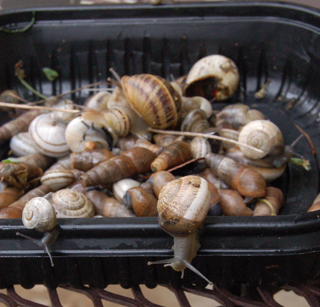
A brown garden snail and milk snail try to escape
after one of many hunts, Austin, Texas, 2/28/12
Photo: Human Flower Project
The glory days of March in Texas are nigh. After an unrelenting drought, good rains late last year and intermittent downpours over the past two months have the wildflower swamis grinning in expectation.
So were we until about a week ago, when we saw that a once-lush patch of bluebonnet plants along the front slope was taking a beating. The leaves were mangled and bitten off. Trampled by pigmy goats?
No. Along the central stalk of two big Agave americanas and deep into a razor sharp sotol, we spotted snails, scores of them, tucked away for the afternoon.
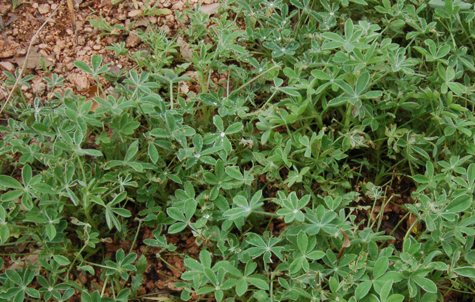
A patch of bluebonnets the snails have grazed

A nearby patch, as yet undamaged
Photos: Human Flower Project
Last fall we’d spotted a lot of snails hanging off the chili petins, but soon as we touched them, they dropped from the stems down into the crowns of the plants, out of reach. Being of the laissez-faire (lazy-fare) school of gardening, we just forgot about all that and took shelter from the sun. But now, with the spring bluebonnet crop threatened, we were prepared to act (cool weather = incentive).
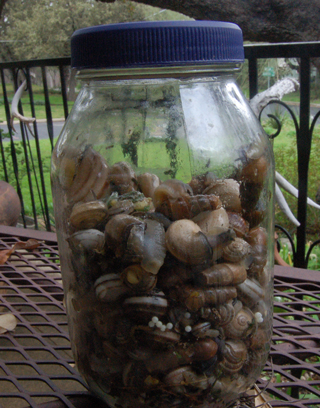 Captives have laid eggs in a mayonnaise jar
Captives have laid eggs in a mayonnaise jar
Photo: Human Flower Project
Better an effort than a poison, we say, when it comes to everything but Bermuda grass, so rather than buy any of the commercial killers we decided to pull the snails off one by one. Using a broom, we could sweep these landlubbing barnacles down the leaves of the agaves (the sotol was impenetrable) and loaded up a plastic rice container with snails. Our friend Stan took them home as a delicacy for his goldfish.
But the next day, just as many snails, maybe more, had climbed back into the big succulents, and the bluebonnets were looking more gnawed than ever.
So for the past three nights we’ve gone out with flashlights to catch them while they’re feeding. Most of them seem to be brown garden snails (Cornu aspersum), though we’ve also found scads of chocolate banded snails (Eobania vermiculata) and milk snails (Otala lactea). Here’s a good resource. And this one is downright adoring.
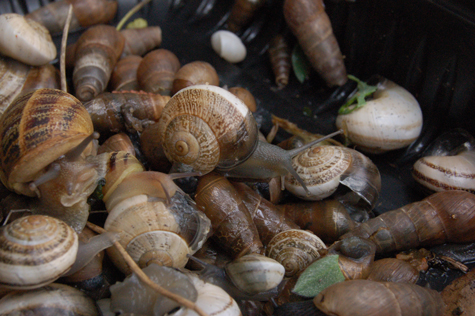
A brown snail glides over other varieties, Austin, TX
Photo: Human Flower Project
Most abundant of all are the cone shaped Decollate snails (Rumina decollata) that especially like to hang out in groups of three or more. (Snails, we’ve learned, are hermaphrodites and typically reproduce by exchanging sperm. Yes, we have seen foursomes….)
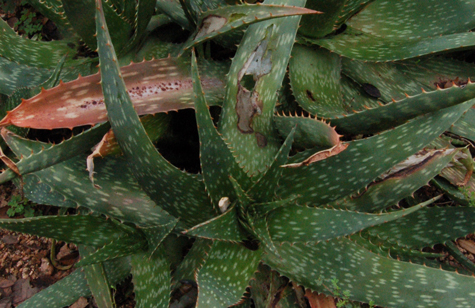
Aloe eaten up by decollate snails. They may not like bluebonnets, but they’re hungry.
Photo: Human Flower Project
We’ve read that these elongated snails are carnivorous and therefore desirable, as they’re supposed to eat the more destructive and rounder varieties that feast on plants. Well, we don’t know who’s devouring whom in the intra-snail struggle, but we DO know that decollate snails, though they hang out at the base of the bluebonnets not along the leaves, have eaten big holes in our aloe plants. Away they go.
For two nights we’ve baited them with dishes of Shiner beer: mildly successful. We’ve consulted with neighbors Cathy and Margaret about the benefits of headlamps and diatomaceous earth. We even received Bible verses from our friend Bruce.
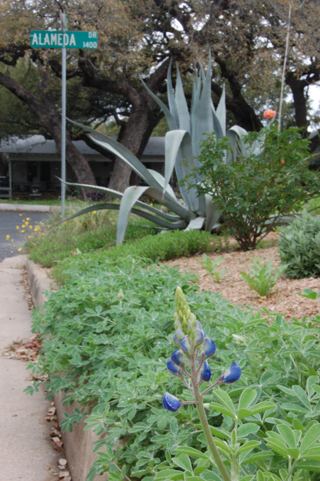 Bluebonnets in early bloom, Feb. 28, 2012, Austin, TX
Bluebonnets in early bloom, Feb. 28, 2012, Austin, TX
Photo: Human Flower Project
We’ve read that some plant varieties, like lavender, will deter snails, but so far we’ve picked about 20 very robust looking brown snails from two clumps of Goodwin Creek (inspecting lavender has its own rewards).
And as yet we’re not rid of the snails. We’ve collected several small bags of them and sent them out, alive, with the trash this morning: the dump seems a good spot for snails to frolic.
Though we want them out of the garden, we’ve also come to admire these creatures. Their whorled shells hark back to when the sea covered Central Texas, and their gray eyes, held out on stems, seem the picture of innocence. Since filling a large mayonnaise jar with snails, we now see about thirty white eggs.
Cathy suggested that we contact University of Texas to see if some scholar would like to observe this phenomenon as it slides along. No thanks. Then we’d have both snails AND academics in the yard! For now, we plan to continue the nighttime vigil, pulling them off by hand and sending them out with the trash next Tuesday.
Meanwhile, the first bluebonnets bloomed here today so all isn’t lost. As Ave Bonar told us long ago, seeing aphids on the roses, “We’re going to have to share.”


snails, snails go away
do not come back another day
the beer is laid the fingers raw
as nighttime picking causes a brawl
no poisons here, but beer alone
gathered to mate in jars, years unknown
away ,away snails, off to the dump
where you all may have fun running amok.